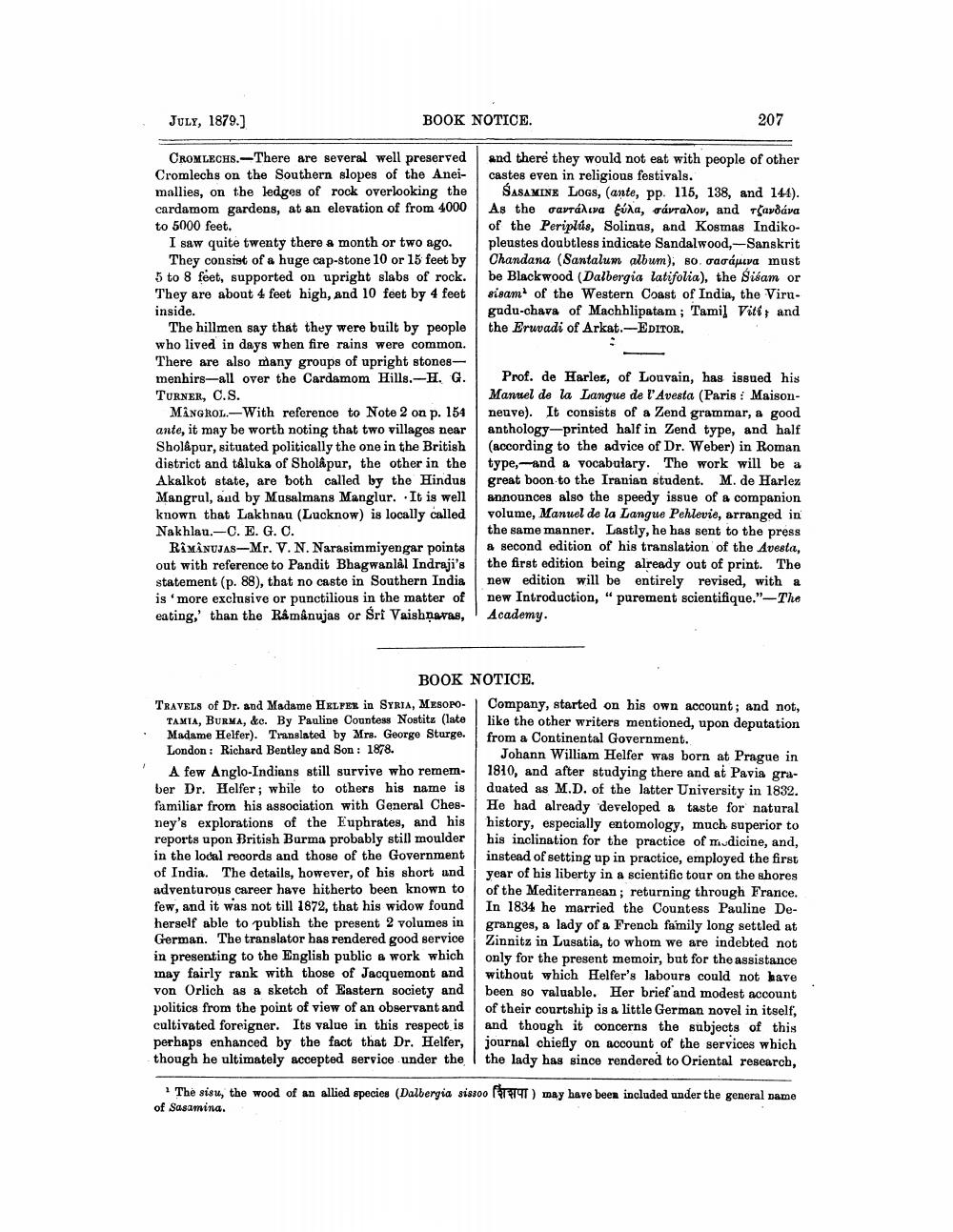________________
JULY, 1879.]
CROMLECHS.-There are several well preserved Cromlechs on the Southern slopes of the Aneimallies, on the ledges of rock overlooking the cardamom gardens, at an elevation of from 4000 to 5000 feet.
BOOK NOTICE.
I saw quite twenty there a month or two ago. They consist of a huge cap-stone 10 or 15 feet by 5 to 8 feet, supported on upright slabs of rock. They are about 4 feet high, and 10 feet by 4 feet inside.
The hillmen say that they were built by people who lived in days when fire rains were common. There are also many groups of upright stonesmenhirs-all over the Cardamom Hills.-H. G. TURNER, C.S.
MANGROL. With reference to Note 2 on p. 154 ante, it may be worth noting that two villages near Sholapur, situated politically the one in the British district and tâluka of Sholapur, the other in the Akalkot state, are both called by the Hindus Mangrul, and by Musalmans Manglur. It is well known that Lakhnau (Lucknow) is locally called Nakhlau.-C. E. G. C.
RAMANUJAS-Mr. V. N. Narasimmiyengar points out with reference to Pandit Bhagwanlal Indraji's statement (p. 88), that no caste in Southern India is 'more exclusive or punctilious in the matter of eating,' than the Râmânujas or Sri Vaishnavas,
TRAVELS of Dr. and Madame HELPER in SYRIA, MESOPOTAMIA, BURMA, &c. By Pauline Countess Nostitz (late Madame Helfer). Translated by Mrs. George Sturge. London: Richard Bentley and Son: 1878.
BOOK NOTICE.
A few Anglo-Indians still survive who remember Dr. Helfer; while to others his name is familiar from his association with General Chesney's explorations of the Euphrates, and his reports upon British Burma probably still moulder in the local records and those of the Government of India. The details, however, of his short und adventurous career have hitherto been known to few, and it was not till 1872, that his widow found herself able to publish the present 2 volumes in German. The translator has rendered good service in presenting to the English public a work which may fairly rank with those of Jacquemont and von Orlich as a sketch of Eastern society and politics from the point of view of an observant and cultivated foreigner. Its value in this respect is perhaps enhanced by the fact that Dr. Helfer, though he ultimately accepted service under the
207
and there they would not eat with people of other castes even in religious festivals.
SASAMINE LOGS, (ante, pp. 115, 138, and 144). Ag the σαντάλινα ξύλα, σάνταλον, and τζανδάνα of the Periplús, Solinus, and Kosmas Indikopleustes doubtless indicate Sandalwood,-Sanskrit Chandana (Santalum album), 80. oaσáuiva must be Blackwood (Dalbergia latifolia), the Sisam or sisam of the Western Coast of India, the Virugudu-chava of Machhlipatam; Tamil Viti; and the Eruvadi of Arkat.-EDITOR.
Prof. de Harlez, of Louvain, has issued his Manuel de la Langue de l'Avesta (Paris: Maisonneuve). It consists of a Zend grammar, a good anthology-printed half in Zend type, and half (according to the advice of Dr. Weber) in Roman type, and a vocabulary. The work will be a great boon to the Iranian student. M. de Harlez announces also the speedy issue of a companion volume, Manuel de la Langue Pehlevie, arranged in the same manner. Lastly, he has sent to the press a second edition of his translation of the Avesta, the first edition being already out of print. The new edition will be entirely revised, with a new Introduction, "purement scientifique."-The Academy.
Company, started on his own account; and not, like the other writers mentioned, upon deputation from a Continental Government..
Johann William Helfer was born at Prague in 1810, and after studying there and at Pavia graduated as M.D. of the latter University in 1832. He had already developed a taste for natural history, especially entomology, much superior to his inclination for the practice of medicine, and, instead of setting up in practice, employed the first year of his liberty in a scientific tour on the shores of the Mediterranean; returning through France. In 1834 he married the Countess Pauline Degranges, a lady of a French family long settled at Zinnitz in Lusatia, to whom we are indebted not only for the present memoir, but for the assistance without which Helfer's labours could not have been so valuable. Her brief and modest account of their courtship is a little German novel in itself, and though it concerns the subjects of this journal chiefly on account of the services which the lady has since rendered to Oriental research,
The sisu, the wood of an allied species (Dalbergia sissoo ) may have been included under the general name of Sasamina.




